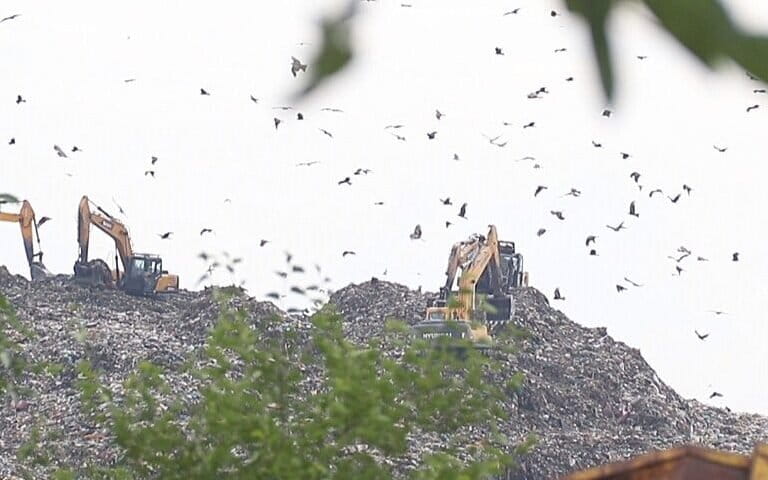- The click beetle has a system of springs and latches that it uses to bend and unbend its body to jump while making a clicking sound.
- The click beetles found in Mexico, Brazil or West Indies also emit light and at some places they are locally referred to as ‘headlight beetles’.
- The click beetle belongs to the family Elateridae and is poorly studied in India even though there are over 800 species of elaterids recorded from the Indian subcontinent under eight subfamilies.
The clicking sound it makes, during an acrobatic jump that it has mastered, gives this insect its name – the click beetle.
Surprise movements or, conversely, feigning dead, are common responses to danger among insects. They also can use sudden sounds that help distract or confuse an attacker. These behaviours may be seen in click beetles as well. But is it to escape from danger? That’s still being investigated.
When it senses danger, the click beetle lies on its back, pretending to be dead. If you go close, it will jump up producing a clicking sound. Once it lands, on its ventral side, it will scamper away. All this, in a matter of few seconds.
Most insects, as do all limb-possessing creatures, use their legs to jump. The click beetles, however, laying on their backs, can jump up high into the air, not only without the use of legs but also with nothing to serve as a grip.
During a laboratory investigation of different species of click beetles, researcher Amol Patwardhan, an assistant professor of zoology at the K.J. Somaiya College of Science and Commerce, Mumbai, found that Metriaulacus bicolor, with a body length between 12-15 millimetres, jumped to a height of 37 centimetres which is more than 25 times its body length.
The click beetle belongs to the family Elateridae. There are over 800 species of elaterids recorded from the Indian subcontinent under eight subfamilies. But there is comparatively very little knowledge about this family of beetles when compared to other families. There is no record of the IUCN status of any Indian elaterid and species in this family may have disappeared without being studied, notes a 2020 overview of click beetles in India by Patwardhan, Harshad Parekar and R.P. Athalye. Click beetles can be found in grasslands and different types of forests, ranging from evergreen, montane or riparian to moist and dry ones.
Scientists believe that 40% of all animal life on Earth is beetles and weevils. Approximately 400,000 species are known to coleopterists (those who study beetles). Scientists are beginning to attribute the existence of such large beetle diversity to their ability to resist extinction.
The diversity exists not only in form but even in their lifestyles.

The beetle’s jump
The click beetle has attracted engineers working in the field of robotics. The beetle has a system of springs and latches that it uses to bend and unbend its body to jump. More specifically, it has a tool in its thorax which can be described as a hinge mechanism, which facilitates this bending and unbending of the body to jump and produce the sound. This hinge has two main components, a peg with a soft cuticle and a lip. While the lip is present on the thorax, the peg rests in a cavity inside the abdomen. When the beetle wants to jump the peg comes out of the cavity and latches on to the lip. The soft cuticle found behind the peg begins to deform. When this deformation – a change in form that also stores energy – is complete, the latch is released, causing the clicking sound. At the same time, the energy released results in a quick unbending motion of the body that facilitates the beetle’s jump. All these changes happen in a matter of milliseconds. While in the air, the click beetle can somersault up to six times, before landing. It can repeat this entire clicking process again and again without any harm to its body.
In their work, researchers Marianne Alleyne, Aimy Wissa and Ophelia Bolmin from the University of Illinois at Urbana-Champaign used high-speed synchrotron X-ray imaging to detail the various mechanisms involved in the beetle’s jump, such as how the beetle is able to store and quickly release energy, the elastic forces involved in the release as well as to explain why the beetle itself is not hurt while performing this clicking jump, or somersaulting motions in the air before landing. The researchers found that the acceleration of motion that this tiny beetle was able to achieve was 300 times more than that of Earth’s gravitational acceleration. And it could repeat the manoeuvres without causing themselves any harm.
“What the beetle teaches us is that it’s possible to move that fast… I hope that one day we’ll be able to design robots that move as fast as click beetles…,” Ophelia Bolmin, lead author of the study, said in a science podcast in 2021.
When the click beetle jumps, it lands on the same place from where it took off. Scientists also found that a click beetle resting on its dorsal (back) side would jump to bring itself upright, even in the absence of a threat. Researchers have noted that the jump is not an escape mechanism but a defence mechanism. They also say that this mechanism evolved mainly for vertical jumping and suggest that jumps are an adaptation for righting rather than to escape although it comes in handy for the latter too.

Let it shine
The click beetles found in Mexico, Brazil or West Indies also emit light. At some places they are locally referred to as ‘headlight beetles’.
For the 16th century islanders, the beetles even served as ‘torchlights’ giving them more light than a candle. The islanders would tie a cucuji, as the beetle is known in Spanish, each on their toes as they went about their night chores. The German naturalist and explorer Alexander von Humboldt reported that a perforated gourd with a dozen or more click beetles inside comfortably served as a reading light. In the 16th century when there was no lighting system, the light emitted by these beetles was quite bright. As the legend goes, the lights were so bright that on seeing them, English explorer, Sir Thomas Cavendish on his voyage to the West Indies in 1634 mistook the beetle’s light for Spanish soldiers and hesitated from landing ashore.
Records also show that people, out to have some fun, would make a paste of the bioluminescent organs and smear it on their faces for a unique glow that would scare people with at night. Thieves too caught on this act and utilised it to scare people in the houses they went to burgle. Of the 10,000 species of click beetles found world over, around 200 species, from neotropical regions are known to emit light. Glowing termite hills have been reported in Brazil as the larvae and pupae developed within these mounds. In 2019 the first bioluminescent click beetle was reported from Asia in Yunnan in China. These beetles, have two round bioluminescent organs that glow as the insect flies at night. The location of these organs vary – they may be found on the prothorax and on the underside of the first abdominal segment, on prothorax only or only on abdomen. Males, females, eggs, larvae and, in some species, even the pupae emit light. They display a wide variation of bioluminescence colours ranging from blue-green, green to orange.
In studying beetle bioluminescence in the 1960s, researcher William D. McElroy and his colleagues found that the Jamaican click beetle, Pyrophorus plagiophthalamus, was capable of emitting different colours of light. They found that the luciferin substrate, on which the enzyme luciferase acts to emit colours, found in the Jamaican beetle was similar to what is found in fireflies. The different colours were the result of differences in the structure of the enzyme luciferase. They were able to isolate DNAs from the beetle that coded for at least four different luciferases which resulted in the single species of click beetle emitting different colours of light.

Then and now
Among the many goddesses Egyptians worshipped was Neith, the patron deity of the city of Sais (which the ancient Egyptians called Zau), who was variously believed to be the goddess of creation, war, weaving and wisdom and predominantly the one who guarded warriors and their weapons.
Researchers have identified three known ancient artefacts that depict click beetles. According to Gene Kritsky, a professor and researcher with expertise in entomology and Egyptology, two carved reliefs (a type of sculpture) from the 1st Dynasty of Egypt (3100-2890 BC) indicate the symbolic significance of this beetle. One is a triangular carving of two elaterids displayed on Goddess Neith’s head. The symbol of two click beetles on arrows has been interpreted as shields and arrows. The second relief shows a portion of the click beetle holding the sacred sceptre of the gods, called the uas or waas sceptre. A gold foil click beetle, inlaid with Neith’s emblems was found in a first dynasty burial at Nag-el Deir. A necklace of golden click beetle amulets dating from the 4th Dynasty (2613-2494 BC) have also been discovered. According to Egyptologist Ludwing Keimer, Agrypnus notodonta was the most likely species represented in ancient carving.
In ancient cultures, observation was the basis for learning. The click beetles with their sound, light and dance show must have led to becoming a creature worthy of reverence. It’s just a conjecture but this reverence could well have become the reason for their association with Goddess Neith who herself was revered for a variety of reasons.
In modern day, science decodes their behaviour and also sees an opportunity to conquer new frontiers in the growing fields of biomimicry and Artificial Intelligence.
CITATION:
Amol P. Patwardhan & R.P. Athalye(2010): Study of the jump of some species of Click Beetles (Coleoptera: Elateridae) Bionano Frontier. Vol.3(1) Jan-June 2010
Science Sessions podcast Shttps://www.pnas.org/post/podcast/click-beetles-jump –
Ophelia Bolmin , John J. Socha, Marianne Alleyne and Aimy A. Wissa, Nonlinear elasticity and damping govern ultrafast dynamics in click beetles. PNAS -118 (5) e2014569118 https://www.pnas.org/doi/10.1073/pnas.2014569118
Ribak G, Weihs D. Jumping without using legs: the jump of the click-beetles (Elateridae) is morphologically constrained. PLoS One. 2011;6(6):e20871. doi: 10.1371/journal.pone.0020871. Epub 2011 Jun 16. PMID: 21698194; PMCID: PMC3116849.
Hendrickx, Stan. “Two Protodynastic Objects in Brussels and the Origin of the Bilobate Cult-Sign of Neith.” The Journal of Egyptian Archaeology 82 (1996): 23-42. Pg 33 doi:10.2307/3822112.
https://thecuriousegyptologist.com/2021/05/14/neith-the-great-mother-and-ruler-of-arrows/
Hogue, C.L. (1993). Latin American Insects and Entomology. University of California Press. p. 256. Available at https://archive.org/details/bub_gb_3CTf8bnlndwC/page/259/mode/1up?q=Click
G.A Perkins (1868). The Cucuyo; or, West Indian Beetle.The American Naturalist, Vol. 2, No. 8 (Oct., 1868), pp. 422-433 (12 pages). https://www.jstor.org/stable/2447310
Banner image: A 2007 image of a click beetle found in Mount Kinabalu national park in Malaysia. Photo by Bernard Dupont/Flickr.













